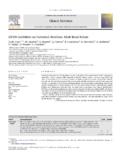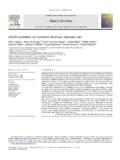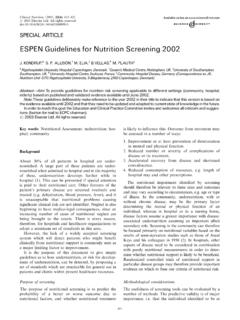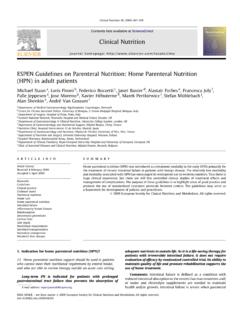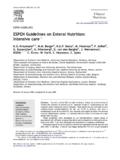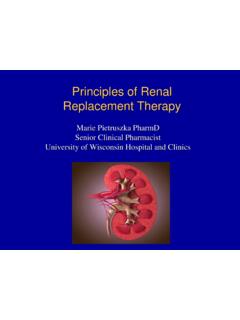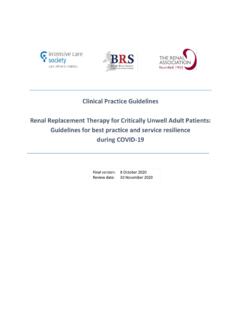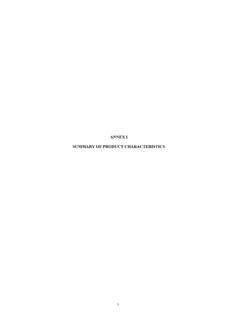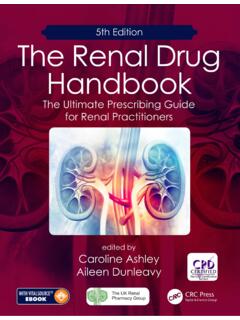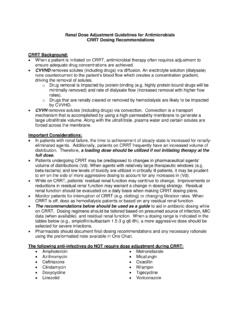Transcription of ESPEN Guidelines on Enteral Nutrition: Adult Renal Failure
1 Clinical nutrition (2006)25, 295 310 ESPEN GUIDELINESESPEN Guidelines on Enteral nutrition : Adult Renal Failure $N. Canoa, , E. Fiaccadorib, P. Tesinskyc, G. Toigod, W. Drumle,DGEM:$$M. Kuhlmann, H. Mann, Ho rlaResidence du parc, Centre Hospitalier Prive , Marseille, FrancebDepartment of Clinical Medicine and Nephrology, Universita degli Studi di Parma, Parma, ItalycDepartment of Internal Medicine, ICU, University Hospital, Plzen, Czech RepublicdIstituto di Clinica Medica, Universita di Trieste, Trieste, ItalyeDepartment of Internal Medicine III, Medical University, Vienna, AustriaReceived 20 January 2006; accepted 20 January 2006 KEYWORDSG uideline;Clinical practice;Evidence based; Enteral nutrition (EN);Oral nutritionalsupplements (ONS);Tube feeding;Acute Renal Failure ;Chronic renalfailure;SummaryEnteral nutrition (EN) by means of oral nutritional supplements (ONS)and tube feeding (TF) offers the possibility of increasing or ensuring nutrient intakein cases where normal food intake is inadequate.
2 These Guidelines are intended togive evidence-based recommendations for the use of ONS and TF in nephrologypatients. They were developed by an interdisciplinary expert group in accordancewith officially accepted standards and are based on all relevant publications since1985. They were discussed and accepted in a consensus of the nutritional impact of Renal diseases, EN is widely used in nephrologypractice. Patients with acute Renal Failure (ARF) and critical illness are characterizedby a highly catabolic state and need depurative techniques inducing massive nutrientloss. EN by TF is the preferred route for nutritional support in these patients. EN bymeans of ONS is the preferred way of refeeding for depleted conservatively treatedchronic Renal Failure patients and dialysis patients. Undernutrition is an independentARTICLE IN $ - see front matter&2006 European Society for Clinical nutrition and Metabolism.
3 All rights :EN, Enteral nutrition . This is used as a general term to include both ONS and tube feeding. When either of thesemodalities is being discussed separately this is specified in the text; Normal food/normal nutrition , normal diet of an individual asoffered by the catering system of a hospital including special diets, gluten-free; lactose-free, etc. diets; ONS, oral nutritionalsupplements; TF, tube feeding; ARF, acute Renal Failure ; CRF, chronic Renal Failure ; CVVH, continuous veno-venous haemofiltration;CRRT, continuous Renal replacement therapies; CAPD, continuous ambulatory peritoneal dialysis; RRT, Renal replacement therapy; RDT,regular haemodialysis treatment$For further information on methodology see Schu tz et further information on definition of terms see Lochs et Corresponding author. Tel.: +33 4918 38835; fax: +33 4918 (N.)
4 Cano).$$The authors of the DGEM (German Society for Nutritional Medicine) Guidelines on Enteral nutrition in nephrology areacknowledged for their contribution to this IN PRESSD ialysis;CAPD;CRRT;Malnutrition;Undernutr itionfactor of survival in dialysis patients. ONS was shown to improve nutritional status inthis setting. An increase in survival has been recently reported when nutritional statuswas improved by full version of this article is available European Society for Clinical nutrition and Metabolism. All rights of statements: Acute Renal Failure (ARF)SubjectRecommendationsGrade71 NumberGeneralMacronutrientrequirements are not so muchdetermined by acute Renal Failure (ARF) as by theseverity of the underlying disease, the type andintensity of extracorporeal Renal replacementtherapy, and by nutritional status and associatedcomplications:Table treatment induces increased losses ofmicronutrientswhich should be micronutrient status because excessivesupplementation may result in ICU patients with ARF, theelectrolytecontent ofmost 1500 2000 kcal Enteral formulae is usuallyadequate.
5 However, requirements can differ and haveto be assessed individually. Plasma electrolytemonitoring should avoid hypokalaemia and/orhypophosphataemia after initiation of enteralnutrition (EN) (refeeding syndrome). is the main but not the only indicationfor uncomplicated ARF use tube feeding (TF) if normalnutrition and oral nutritional supplements (ONS) arenot sufficient to meet estimated severe ARF, the recommendations for TF are thesame as for other ICU patients (see guideline Intensive Care ). If possible initiate EN within 24 uncomplicated ARF, when spontaneous alimentationis insufficient, ONS may be useful to meet nasogastric tube as the standard access for theadministration of EN. Jejunal tube placement may beindicated in the presence of severe impairment ofgastrointestinal some cases where requirements cannot be met viathe Enteral route, supplementary parenteral nutritionmay be of formulaStandard formulae are adequate for the majority case of electrolyte derangements formulae specificfor chronic Renal Failure can be : Grade of recommendation; Number: refers to statement number within the Cano et IN PRESSS ummary of statements: Conservatively treated chronic Renal Failure (CRF)SubjectRecommendationsGrade71 NumberGeneralAn energy intake of 35 kcal/kgBW/day is associatedwith better nitrogen balance and is recommended instable CRF patients in the range of ideal body weight710%.
6 Or undernourished patients may needadjustments of energy for protein intakes of metabolicallystable patients:Table for mineral requirements ofmetabolically stable patients:Table TF when adequate oral intake is not possibledespite nutritional counselling and EN in: Patients with CRF and other catabolic intercurrentacute conditions in whom oral feeding is not these patients metabolically and nutritionallylike ARF CRF patients in whom adequate oral intake cannotbe achieved. Consider overnight TF in order tooptimize nutrient Elderly patients with CRF may require specialattention. The nutrient requirements and the need fornutritional support in elderly patients with renalfailure have not been studied, although theprevalence of uraemic patients older than 75 years offormulaUse standard formulae for short-term EN inundernourished CRF EN45 days use special or disease-specificformulae (protein-restricted formulae with reducedelectrolyte content).
7 Amino acids and ketoanalogues, inassociation with very low protein formulae, areproposed to preserve Renal : Grade of recommendation; Number: refers to statement number within the of statements: Patients on maintenance haemodialysis therapy (HD)SubjectRecommendationsGrade71 NumberGeneralIn acutely ill HD patients, the nutritionalrequirements are the same as in ARF requirements of metabolically stablepatients:Table requirements of metabolically stablepatients:Table to dialysis-induced losses, water-soluble vitaminsshould be supplied: folic acid (1 mg/day), pyridoxin(10 20 mg/day) and vitamin Guidelines on Enteral Nutrition297 ARTICLE IN PRESS(30 60 mg /day) (C, 13). Vitamin D should be givenaccording to serum calcium, phosphorus andparathyroid hormone haemodialysis does not induce significanttrace-element losses. However, in depleted patients,zinc (15 mg/day) and selenium (50 70mg/day)supplementation may be support is indicated in undernourished HDpatients as defined by low nutritional indices, mainlyBMIo20 kg/m2, body weight loss more than 10% over 6months, serum albumin less than 35 g/l and serumprealbumin less than 300 EN in: HD patients with intercurrent catabolic acuteconditions in whom normal nutrition is not these patients metabolically and nutritionallylike ARF HD patients in whom adequate oral intake cannotbe achieved.
8 Consider TF to optimize nutrient patients on HD, in neurology,patients in nursing homes in need of EN. Administer TFadapted to the metabolic changes associated with undernourished HD patients with poor complianceto ONS and not requiring daily EN by TF, intradialyticparenteral nutrition can be ONS to improve nutritional TF if nutritional counselling and ONS should be the preferred route in conscious through a nasogastric tube should be used whenONS is unsuccessful or inadequate to reach therecommended patients with gastroparesis, unresponsive toprokinetic treatment, nasojejunal TF is placement of percutaneous endoscopicgastrostomy (PEG) or percutaneous endoscopicjejunostomy (PEJ) for long-term TF in selected offormulaTreat acutely ill patients with CRF on dialysis in asimilar manner to those with standard TF prefer HD-specific formula content in phosphorus and potassiumshould be : Grade of recommendation.
9 Number: refers to statement number within the Cano et with Renal Failure represent an extremelyheterogeneous group, whose nutritional require-ments can therefore differ widely. Even though theevidence supports the use of the Enteral instead ofthe parenteral route, the optimal method ofnutritional support remains controversial, espe-cially in acute Renal Failure (ARF). Moreover, onlya few Enteral formulae have been developedaddressing the specific needs of the variousdifferent groups. Finally, few systematic investiga-tions have been performed, and controlled trialswith an acceptable study design are rare. As thedevelopment of Guidelines using the criteria ofevidence-based medicine is rarely possible for thispatient group, the following recommendationsshould be regarded as expert opinion reviewIn developing recommendations, the keywords Enteral feeding ; nutrition ; feeding tube ; ARF ; chronic Renal Failure (CRF) ; haemodia-lysis therapy ; peritoneal dialysis were used forliterature studies of Enteral nutrition (EN) in renalfailure have only investigated feasibility and toler-ance, rather than the impact on metabolic para-meters and nutritional status.
10 There are no studieswith hard end points such as outcome, hospitalstay, incidence of complications, etc. Studiescomparing different Enteral formulae are EN in patients with ARFA mong patients with Renal Failure , those with ARFand critical illness represent by far the largestgroup receiving EN. ARF, especially in the ICU,seldom occurs as isolated organ Failure but isusually one component of more complex metabolicchanges, in the setting of multiple organ programs for ARF patients must not onlyconsider the particular metabolic derangementsassociated with Renal Failure and with the under-lying disease process and its associated complica-tions, but also the derangements in nutrientbalances due to Renal replacement therapies(RRTs). This is especially true when higher effi-ciency depurative techniques are used (continuoustherapies such as continuous veno-venous haemo-filtration (CVVH), or prolonged intermittent mod-alities such as sustained low-efficiency , it should be remembered that nutrientrequirements can change considerably during thecourse of the underlying illness itself (see alsoguidelines Intensive care ).)
